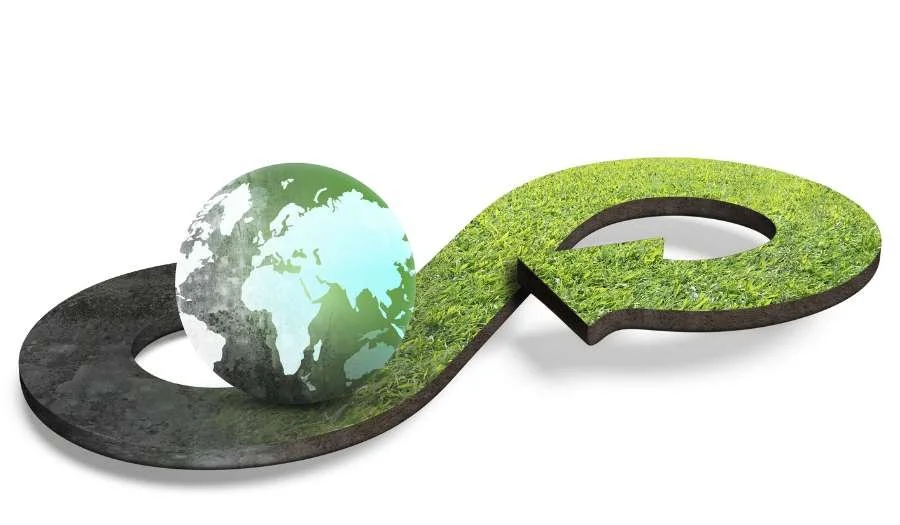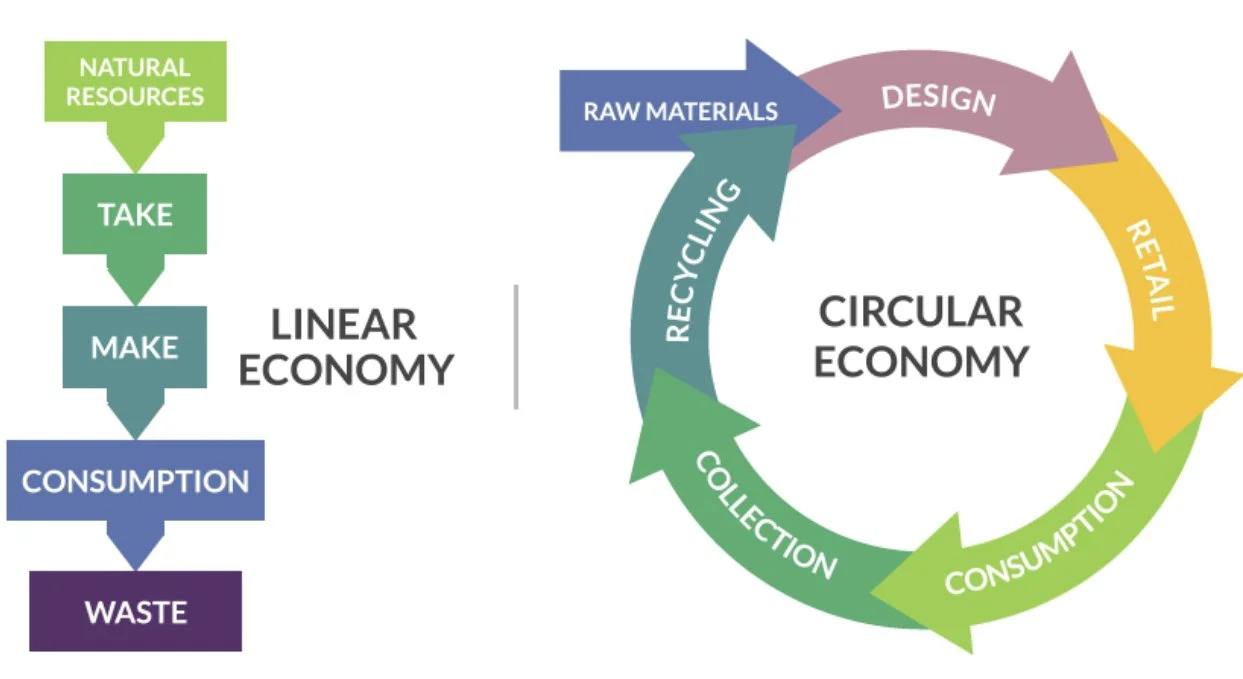Circular economy, our new way to survive
Linear economy
Before we discuss the circular economy and its advantages, it is crucial first to comprehend what a linear economy is. The conventional manufacturing model known as the "linear economy" has long dominated the world economy. In this process, products are created from raw materials, sold, utilized, and discarded as waste. In short, it can be summarized as Take, Make and Dispose of. The issues with these methods are present throughout the production cycle in both industrial farming and the industry which employ this pattern. Greenhouse gas emissions, hazardous spills, and pollution from the mining, manufacturing, and transportation of commodities severely impact our environment and civilizations. Vast meadows rich in biodiversity are being removed to produce food for our continuously growing population. The "linear economy" reality points to an underlying issue: the increasing demand for fertilizers and pesticides on soils that are only steadily getting worse, preventing any further possibility of producing more food. Considering that in the end, it is estimated that more than a third of all food produced is lost or wasted every year, with 35% thrown out by supermarkets, shops, and households, even though a large portion is still perfectly suitable for consumption. This process is therefore known as "linear economy," as resources only flow in one direction. It is stuck on a one-way street that leads to an ever-increasing pile of waste; the problem with this model is that it acts as if there are endless resources, which we all know is not the case. The probability of these negative repercussions growing in tandem with the middle-class population significantly boosts the costs to our economy. The global cost of marine plastic pollution alone is $2.5 trillion annually.
All ideas, such as recycling, clean-ups, reducing consumption, and resource efficiency, are valuable. Still, when applied to a fundamentally flawed system, such as the linear economy, which is focused on pure extraction, production, and disposal, there is nothing that can be done to adjust the system's essential boundaries and accomplish the desired conclusion. Therefore,this is when the concept of circular economy comes into place .
What exactly is a Circular economy?
In a circular economy, goods and resources travel through the system in a series of cycles that attempt to either retain economic value or renew the biosphere in a circular economy. Items are manufactured to be manufactured again, and the entire process is powered by renewables. Energy usage will be lowered in the future through operations such as repairing and remanufacturing. Resources in a circular economy are treated as finite resources. Contrary to the throw-away and replace culture, the circular economy embraces a return and renew culture, with components intended to be dismantled and regenerated. In this case, a company in a circular economy not only recycles items but also retains ownership of them throughout the process. This strategy transforms businesses into service providers rather than dealers of tangible goods, and data suggests that many businesses are eager to participate! An example of this is H&M’s Four Steps to Circular, particularly their most outstanding in-store used garment collecting program. By 2022, H&M will have diverted almost 29,000 tonnes of waste from landfill to be repurposed or transformed into new items. Adidas created the UltraBoost DNA Loop sneakers from a single substance (TPU) with no adhesive. Adidas advertises the shoes as shoes that buyers would never own and will return once they are finished.
This progress is not only evident in companies but in governments too! As such, the EU adopted an action plan in 2015 to make supply chains more circular, including production, consumption, repair, manufacturing, and waste management.
How does the circular economy work?
The circular economy follows three principles:
Eliminate waste and pollution
Rather than addressing the symptoms of pollution and figuring out how to deal with garbage that has already been created, we need to develop processes and technologies that prevent waste from being created in the first place. As a result, mycelium, which binds agricultural byproducts together, is being used to create packaging. This is light, compact, and protective. This concept by Evocative design substitutes the unavoidable waste of single-use plastics or polystyrene with a product that, on the other hand, feeds the soil.
Keep products and materials in use
A circular economy encourages actions that retain value in the form of energy, labor, and materials; for example, developing durable, reusable, remanufacturing, and recycling things to keep products circulating for longer, minimizing our reliance on limited energy and resources. Furthermore, its economy allows for many diverse applications for materials rather than just using them up, as demonstrated by MUD Jeans' creation of completely circular jeans 40% made out of post-consumer recycled cotton produced from discarded jeans.
Regenerate natural systems
This economy avoids the use of fossil fuels and non-renewable energy; by supporting renewable energies, it enhances natural systems and draws down carbon, which builds resilience in the long term.
What are the benefits of a circular economy?
It is critical to move away from a linear economy and toward a circular one, given the world's accelerating resource demand, which has tripled since 1970 and may double once more by 2050. Evidence suggests that these changes will positively influence industries, sectors, and people's lives in addition to the environment. The circular economy offers the chance to:
Reduce emissions
Circular economy strategies that reduce our use of resources can cut up to 39% of the global greenhouse gas emissions (22.8 billion tons), which will play a crucial role in reducing the likelihood of the possible dangerous impacts of climate change we can face. Such strategies include shifting towards recycled materials that would alleviate the need to produce virgin plastics and synthetic fibers and changing consumption patterns. As such, according to the latest circulatory gap report, it was estimated that switching to a circular economy would ease pressure on virgin materials by 28%. As a result, the circular economy will decrease the carbon footprint of products by promoting dematerialization, reuse to cut down on new materials, and energy-efficient production using renewable energy sources. A study by the Ellen MacArthur Foundation and McKinsey & Co. demonstrates that by implementing circular economy strategies in just five key industries—cement, aluminum, steel, plastics, and food—by 2050, 9.3 billion tonnes of CO2e will have been eliminated, which is the equivalent of reducing current transportation emissions to zero.
Develop new opportunities
The circular economy opens up new possibilities for material recycling. Allowing the economy to expand when resource consumption is no longer the main factor determining its success. This will increase GDP by motivating businesses to create durable, recyclable, and reusable items. According to research, the EU's transition to a circular economy may boost GDP by 12 percentage points by 2050. Moreover, a study conducted with the Ellen MacArthur Foundation shows that such a strategy may increase Europe's resource productivity by 3% by 2030, leading to cost savings of €600 billion annually and an additional €1.8 trillion in other economic benefits.
Benefit the society
New employment will be created due to the transition to a circular economy in manufacturing, engineering, design, and recycling sectors. According to Global Climate Action Conference calculations, the transition to a circular economy might result in up to 65 million additional employment by 2030. Additionally, it will increase the material cost savings for producers because, unlike in a linear economy, where businesses view waste as costs associated with disposal, in a circular economy, businesses view waste as valuable resources that can be used to create new products, saving money on both raw materials and disposal costs. Moreover, companies are more resistant to economic downturns since they may acquire recycled resources rather than new materials, making them less likely to encounter fluctuations in raw material costs.
Written by Yasmin Uzykanova

